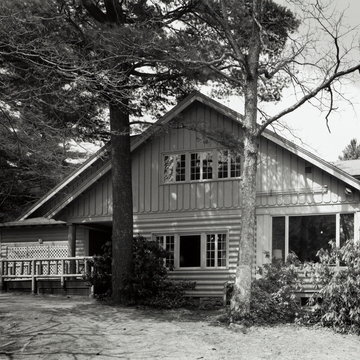This campus covers 2,300 acres of woods, fields, and ponds and includes two complexes of architectural interest. First, the road winds past Parker Farm, including a two-and-one-half-story Greek Revival house and an impressive complement of early twentieth-century farm buildings. Once the Parker District School (destroyed by fire) and facilities for the town poor farm were also on the preserve. Finally, the road terminates at the luxurious hideaway where W. Alton Jones relaxed from his duties as president of Cities Service Petroleum. The estate, now a University of Rhode Island conference center, focuses on two lodges: Whispering Pines, built for the Jones family, and Nettles, for their visitors, both overlooking a scenic pond. Whispering Pines, a blown-up version of a log bungalow, is among the best examples of rustic work in the state. A plaque in the upstairs master bedroom celebrates a visit by President Eisenhower. The university has made a few sympathetic additions since acquiring the estate in 1965 as a gift from the foundation Jones established in his name. A spur road leads off to an environmental studies complex, which wins no architectural prizes for environmental concern. Finally, the estate also contains the barely visible remains of the Bela Clapp Acid Factory, which once derived acetic acid from wood harvested in local forests. Trundled by wagon to the nearest railroad station in Greene, the hogsheads of acid were shipped principally to the B. B. and R. Knight textile mills in Riverpoint, Natick, and Arctic. (This history explains how the university's environmental studies program eventually found a location on Acid Factory Creek.) Jones's fishing lake was once the factory's millpond.
You are here
Alton Jones Campus, University of Rhode Island
c. 1830, Parker Farm. 1930s with c. 1965 additions, W. Alton Jones hunting and fishing estate (now University of Rhode Island Conference Center). End of Matteson Plain Rd. (center open only to conferees)
If SAH Archipedia has been useful to you, please consider supporting it.
SAH Archipedia tells the story of the United States through its buildings, landscapes, and cities. This freely available resource empowers the public with authoritative knowledge that deepens their understanding and appreciation of the built environment. But the Society of Architectural Historians, which created SAH Archipedia with University of Virginia Press, needs your support to maintain the high-caliber research, writing, photography, cartography, editing, design, and programming that make SAH Archipedia a trusted online resource available to all who value the history of place, heritage tourism, and learning.

